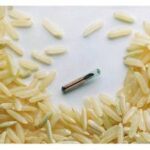Electron spectroscopy is now a growing area of use for surface analysis of most solids such as the silicon microchip. For most of them to do a specific function, there must be a charged surface. For that to be achieved, our company added a small amount of boron (B) and phosphorous (P) to certain regions of the chip. Since then, we have been experiencing some technical problems. Either the elements have been put in the wrong position, or there could be some type of contamination on the chip from the manufacturing process. In 1957, scientists at Fairchild Semiconductor designed a silicon integrated circuit using the “planar process”, in which all circuit activity occurred on a few related planes. Since this method proved to be more proficient and simple to make, it became the standard construction for all integrated circuits and later the microchip.
Pure silicon is used as the base for this system. If phosphorus is combined with it, silicon gains excess electrons. It is called “n-type” silicon. If boron and silicon are combined, it lacks electrons. That is called “p-type” silicon. When the two are combined, electrons and openings from incomplete bonds flow under applied voltage. In order for the chip to function properly, the silicon materials must be combined on one surface, either side by side or stacked, into well-defined areas of the plane. This provides an electron pathway along the microchip.
There are three types of chip designs: standard, semi-custom, and custom. Standard chips follow the manufacturer’s design and are the least costly to fabricate. Semi-custom chips have a standard design; however, they are more adapted for certain applications such as manipulating logic functions. Custom chips have a specific design and layout for more specific applications. They are very expensive and take the longest to design and manufacture. It must be noted that if the chip design does not follow certain geometric design rules, that it will not reliable or operable.
According to Fleischer at the Massachusetts Institute of Technology, since the chip fabrication process is drawn out and expensive, the chip must be verified and analyzed before it is manufactured. Many tools are used to check for errors. With so many inspections in the chip design process, any type of technical problem would result from the manufacturing process.
From my investigations, using Auger Electron Spectroscopy (AES) and X-ray Photoelectron Spectroscopy (XPS) would be the best instrumentation to use to solve these problems. They can provide both qualitative and semi-quantitative chemical information about the composition of a surface layer of a solid, ranging from 1 to 100 angstroms in thickness. Both instruments are widely available.
Each instrument uses a primary beam and a secondary beam for spectroscopic examination of the surface. The primary beam usually consists of x-ray photons for XPS instrumentation, or electrons for AES. The secondary beam consists of electrons for both instruments. The instrumentation for AES and XPS consist of a source, sample holder, analyzer, detector, and a signal processor and readout. The only difference between the two is that the source for AES is an electron gun rather than a x-ray tube used for XPS.
Each method has its particular strengths that combined would be effective for this particular problem solving method. For XPS, you can see more than one peak for a given element. They correspond to each orbital. For example, the binding energies for 1s electrons increase with atomic number because of the increased positive charge of the nucleus. Phosphorous has been observed to have peaks for 2s and 2p electrons. Boron has been observed at 1s. The electron configuration for boron is 1s22s22p1; for phosphorous, it is 1s22s22p63s23p3.
Auger Electron Spectroscopy is very sensitive to atoms of low atomic number with the exception of hydrogen and helium. Boron (B) has an atomic number of five and phosphorous is number fifteen. Since these are the elements of interest, this would be very beneficial. AES also has a high spatial resolution, allowing a detailed examination of solid surfaces.
Spectral effects give more information about the sample and the quantitative result. Many of the electron peaks are very sharp, so the resolution can define the peak width. The primary electron beam probes the surface of a solid material while the secondary electrons are emitted and analyzed.
As noted earlier, material on a microchip must be either side by side or stacked to provide an electron pathway. For each pathway, there are a certain number of Auger electrons that are generated by inelastically scattered primary electrons leaving the surface, and there are those from the incident beam. Each set of electrons collides and the result is backscattered electrons. The inelastic scattering is strong and occurs between 50-2500eV. Thus, electrons bearing these energies have to be near the surface or the scattering process will absorb all of the energy that they need to go into vacuum. Once the last Auger electron leaves, the kinetic energy can then be determined. Each signal for each element can then be plotted.
All samples to be analyzed by AES must be in the form of a conducting solid up to 2.5 cm2. Also, the samples must not be contaminated. If the samples are difficult to analyze, this must indicate that there is some foreign substance present.
The biggest uses of AES, according to Turner and Schreifels, is depth profiling. Basically, a sputter gas, usually argon or xenon, is chosen to etch away the surface while determining the elemental composition. Better results are obtained with low beam energies at approximately 500eV.
XPS has been used for the identification of oxidation states of elements contained in inorganic compounds due to the fact that binding energies increase, as the oxidation state becomes more positive. When outer electrons are present, there is no longer an attraction of the nucleus for the core electron, causing a chemical shift. When one of these electrons is removed, the effective charge for the core electron increases with the binding energy.
XPS spectra give both qualitative and quantitative information about the type and number of atoms present in a compound. It can also distinguish oxidation states of an element. All elements can be analyzed with the exception of hydrogen. Chemical bonding to any species on the surface can be used for identification. Also, there is minimal sample preparation and damage.
The use of parallel imaging and a magnetic object lens produces XPS spectra of structured surfaces. Turner and Schreifel conducted an experiment where samples were put into a strong magnetic field so that the electrons could obtain more energy. The magnetic lens combined with a device called a concentric hemispherical analyzer (CHA) that would increase the signal intensity five times more. Most spot sizes are approximately 100 um. Using this method, they found tin (Sn) and phosphorous (P) can be detected on an iron-nickel alloy. Using this same method, one should also be able to detect phosphorous on a silicon microchip.
Boron, according to Trehan, Lifshitz, and Rabalais, produces a thin film of boron nitride when it interacts with N2+ ions. Its thickness depends on the ranges of ions in boron. Mild argon sputtering cleaned the boron used. This sputtering can also be done on a surface so that one can do elemental analysis at different depths. It is also helpful when looking for any impurities that may be present. One can see the dramatic changes in both the XPS and AES spectra when the experiment begins with clean boron to the formation of BN.
In conclusion, if boron and phosphorous were not put side by side in a plane, then the microchip will fail. If there is any contamination at all, it can be detected by AES and XPS. Mild argon sputtering can also clean the surface. All samples being analyzed must be free of contamination. I believe that to solve this problem that each element should be cleaned with argon first to get rid of any possible contamination. Next, they should be arranged in a plane on the microchip so that those electrons can flow in a path. If any other substance is found on the microchip during surface analysis, the argon sputtering should be able to remove it.
The quantitative methods of the two methods that were discussed are considered together because they use the same spectrometers and the same detection systems. More scientists are becoming interested in the various techniques. For the future, surface analysis using electron spectroscopes will continue to grow and quickly improve.
Bibliography
1. Nebesny, Kenneth W., Maschhoff, Brian L., and Armstrong, Neal R. Quantitation of
Auger and X-ray Photoelectron Spectroscopies. Analytical Chemistry 61 (7), April 1,
1989, pp. 464A-481A.
2. Trehan, R., Lifshitz, Y., and Rabalais, J.W. Auger and x-ray electron spectroscopy studies
of hBN, cBN, and N2+ ion irradiation of born and boron nitride. Journal of Vacuum
Science and Technology A 8(6), Nov/Dec 1990, pp. 4026-4032.
3. Zommer, L. Determination of the spectrometer transmission function for XPS quantitative
analysis. Vacuum 46 (5-6), pp. 617-620, 1995.
4. Seah, M.P. Quantitation and measurement by Auger electron spectroscopy and X-ray
photoelectron spectroscopy. Vacuum 36 (7-9), pp. 399-407,1986.
5. Turner, Noel H. and Schreifels, John A. Surface Analysis: X-ray Photoelectron
Spectroscopy and Auger Electron Spectroscopy. Analytical Chemistry 68(12), 309R-
331R, June 15, 1996.
6. Turner, Noel H. and Schreifels, John A. Surface Analysis: X-ray Photoelectron
Spectroscopy and Auger Electron Spectroscopy. Analytical Chemistry 72(12), 99R-110R
June 15, 2000.
7. Fleischer, Dorothy A. Chipping Away at VLSI Computer-Aided Design. RLE Currents
Vol. 5, No. 2, Spring 1992.
8. Skoog, Holler, and Neiman. Principles of Instrumental Analysis, Fifth Edition, pp.536-
546.
9. www.analytical.org




